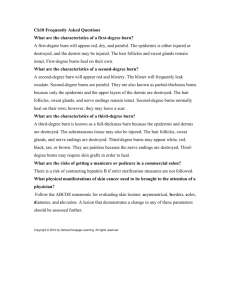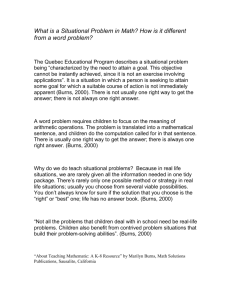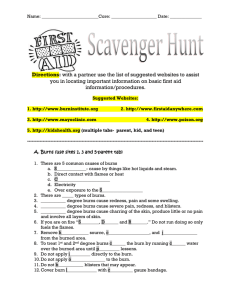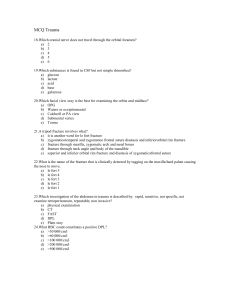Cadet Name: Date: (U4C2L4:F4) What kind of fracture is shown in
advertisement
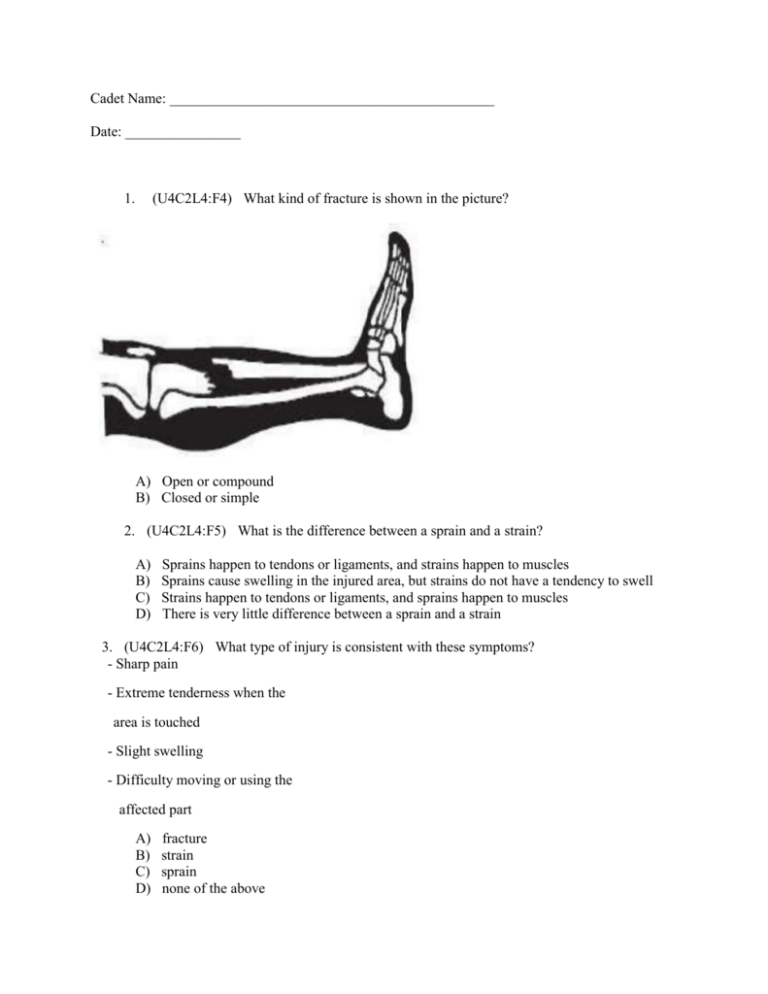
Cadet Name: _____________________________________________ Date: ________________ 1. (U4C2L4:F4) What kind of fracture is shown in the picture? A) Open or compound B) Closed or simple 2. (U4C2L4:F5) What is the difference between a sprain and a strain? A) B) C) D) Sprains happen to tendons or ligaments, and strains happen to muscles Sprains cause swelling in the injured area, but strains do not have a tendency to swell Strains happen to tendons or ligaments, and sprains happen to muscles There is very little difference between a sprain and a strain 3. (U4C2L4:F6) What type of injury is consistent with these symptoms? - Sharp pain - Extreme tenderness when the area is touched - Slight swelling - Difficulty moving or using the affected part A) B) C) D) fracture strain sprain none of the above 4. (U4C2L4:F8) Which injured arm is supported and immobilized with a splint? A) B) C) 5. (U4C2L4:F9) A __________ occurs when a joint comes apart and stays apart with the bone ends no longer in contact. A) B) C) D) sprain dislocation strain fracture 6. (U4C2L4:Q1) While playing basketball, a teammate fell and injured his shoulder. You evaluated him, but you can't tell if it's broken or dislocated, so you immobilize it with a sling. You tell him to seek further medical attention, but since you aren't sure about the RICE procedures, you have your friend tell him. Which one would you tell him was wrong? A) Rest - helps injuries heal faster. B) Ice - helps reduce swelling and pain (but remove ice when the area gets numb). C) Compression - apply pressure to prevent additional swelling and to squeeze debris out of the wound. D) Elevation - elevate the feet so that blood flows more freely towards the heart and brain. 7. (U4C2L4:Q2) While you and a friend were out hiking, your friend fell down a small but steep embankment. You can see that her leg is broken because the bone broke through the skin. She is bleeding, but only slightly. When she looks at her leg, she turns pale and starts breathing rapidly. What should you do next? A) Tell her "It's not too bad. You will be OK." B) Begin RICE procedures. C) Gather splinting material. D) Apply pressure to stop the bleeding. 8. (U4C2L4:G1) Which of the following is a symptom of shock? A) B) C) D) Skin is pale or blue and cold to the touch. Skin is blue and hot to the touch. Skin is flush (or red) and hot to the touch. Skin is hot to the touch and the eyes roll back in the head. 9. (U4C2L4:G2) T or F: Fainting is a mild form of shock. A) True B) False 10. (U4C2L4:G3) What is an open fracture? A) B) C) D) One in which the two sides of the break do not touch each other One in which the sharp edges of the bone cut through the skin A break of a bone joint A break with two or more fractures of the same bone 11. (U4C2L4:G4) Another name for an open fracture is ____________. A) B) C) D) An acute fracture An obtuse fracture A compound fracture A simple fracture 12. (U4C2L4:G5) The RICE formula is used to treat bone, joint, and muscle injuries. Explain what RICE stands for. A) B) C) D) Rap, Ice, Compress, and Elevate Rest, Immobilize, Compress, and Elevate Rest, Ice, Compare swelling, and Elevate Rest, Ice, Compression, and Elevation 13. (U4C2L4:G7) How do you make a field-expedient sling? A) B) C) D) Pin the victim's shirttail up to support the weight of the arm. Use two socks as a sling. Use the sling as a weapon. Use any ropes or strings available. 14. (U4C2L4:G8) Explain the difference between a simple and a compound fracture. A) A simple fracture has much bleeding, while a compound fracture has very little. B) A simple fracture has torn skin, while a compound fracture has none. C) In a simple fracture, no skin is torn by the bone. In a compound fracture, the sharp edges on the bone protrude through the skin. D) A simple fracture does not require medical attention, while a compound fracture requires immediate medical attention. 15. (U4C2L4:G9) What physiological events cause a body to go into shock? A) Seeing a catastrophic event B) Thinking of something that causes a phobia C) To correct damage from an injury and protect its blood supply, a human body routes blood away from the outer tissues to organs inside the body, which prevents adequate blood and oxygen from reaching the brain D) The human body routes all blood away from the heart and to the extremities to keep them warm, which drains the brain of blood 16. (U4C2L4:G10) Describe the symptoms of a victim who is in shock. A) B) C) D) Skin is warm and clammy Skin is cold and clammy Skin is cold and dry Skin is warm and dry 17. (U4C2L4:G14) RICE is an acronym for _____________. A) B) C) D) Rice, Ice, Cereal, and Eating Running, Isometric, Calisthenics, and Exercise Reflect, Infer, Clarify, and Evaluate Rest, Ice, Compression, and Elevation used to treat bone, joint, and muscle injuries 18. (U4C2L4:G15) What is the most important action to take when dealing with a fracture? A) B) C) D) Stop the bleeding Apply a tourniquet To immobilize injured bones to prevent further damage Apply a gauze dressing 19. (U4C2L4:F10) You and a friend are out running when your friend trips and falls. He is in a lot of pain and says his ankle popped. What do you do? A) B) C) D) Call for help. You know nothing about injuries. Make a splint and get him to walk home leaning on you. Tell him not to move and check his ankle. Attempt to pop his ankle back into place. 20. (U4C2L4:V1) It's the Question Game! the separation of a bone from its joint A) B) C) D) What is clammy? What is a closed fracture? What is a dislocation? What is a ligament? 21. (U4C2L4:V2) It's the Question Game! an injury caused when a muscle or tendon is overstretched A) B) C) D) What is a strain? What is a sprain? What is an open fracture? What is a dislocation? 22. (U4C2L4:V3) It's the Question Game! a fracture in which the broken end of a bone pierces the skin A) B) C) D) What is a ligament? What is an open fracture? What is a strain? What is a closed fracture? 23. (U4C2L4:V4) It's the Question Game! to lose consciousness briefly because of temporary decrease in the amount of blood that flows to the brain A) B) C) D) What is fainting? What is a dislocation? What is a splint? What is clammy? 24. (U4C2L4:V5) It's the Question Game! damp, soft, sticky, and unusually cool A) B) C) D) What is a ligament? What is clammy? What is fainting? What is a dislocation? 25. (U4C2L4:V6) It's the Question Game! a fibrous band of tissue that holds bones together at a joint A) B) C) D) What is an open fracture? What is clammy? What is trauma? What is a ligament? 26. (U4C2L4:V7) It's the Question Game! to support and immobilize a body part with a stiff material A) B) C) D) What is a strain? What is a splint? What is an open fracture? What is a dislocation? 27. (U4C2L4:V8) It's the Question Game! a fracture in which the broken bone does not push through the skin's surface A) B) C) D) What is a closed fracture? What is trauma? What is an open fracture? What is fainting? 28. (U4C2L4:V9) It's the Question Game! a behavioral state resulting from mental or emotional stress or physical injury that has lasting effect on the mind; a physical wound or injury A) B) C) D) What is a splint? What is an open fracture? What is trauma? What is a sprain? 29. (U4C2L4:V10) It's the Question Game! an injury caused by twisting a ligament or tendon around a joint A) B) C) D) What is a strain? What is a dislocation? What is a splint? What is a sprain? 30. (U4C2L5:F1) Scenario: You and your friends spent a fun day at the beach but forgot your sunscreen. Later that evening you notice blisters across your friend’s back and realize he got sunburned. How bad are the burns? A) first-degree B) second-degree C) third-degree 31. (U4C2L5:F3) After calling 911, what is the first thing you do to treat an electrical burn victim? A) B) C) D) Monitor ABC’s since electrocution can cause cardiac and respiratory emergencies. Cover the area of the burn with a dry, loose bandage. Secure the area by turning off the power source. Apply ointment to the burned area. 32. (U4C2L5:F4) Why do you only treat dry chemical burns with water if a large amount of water is available? A) Small amounts of water can cause more burning. B) You do not treat chemical burns with water. C) You must flush the area for no more than 5 minutes. 33. (U4C2L5:F5) What title should be on this poster for preventing burns? A) B) C) D) E) Prevention of 1st Degree Burns Prevention of 2nd Degree Burns Prevention of 3rd Degree Burns Prevention of Electrical Burns Prevention of Chemical Burns 34. (U4C2L5:F6) A friend calls you to ask how to perform first aid for a first-degree, caustic burn that her little brother has on his arm and shoulder. What's the first thing you should tell her? A) B) C) D) Put on gloves and/or goggles to protect herself. Remove the chemical from the skin and clothing. Move her brother away from the electrical source. Put pressure on the burn with a sterile dressing. 35. (U4C2L5:F7) When treating first-, second-, or third-degree burns which depth of burn is not treated with water? A) first-degree burns B) second-degree burns C) third-degree burns 36. (U4C2L5:Q2) You called 911 to request emergency assistance for a victim burned in a fire. The victim tells you that he is in a lot of pain. His skin has many blisters and is severely swollen. What should you tell the 911 operator when he asks, "How bad are the burns?" A) "They are first-degree burns." B) "They are second-degree burns." C) "They are third-degree burns." 37. (U4C2L5:Q3) While watching a storm from your window, you and a friend see a power cable fall and land on your neighbor who was walking her dog. After telling your friend to call the power company and 911, you run outside to help. Your neighbor and her dog are unconscious, soaking wet, and are both face up in a shallow puddle. The cable is on top of both of them. What should you do next? A) Evaluate your neighbor using the ABC's of lifesaving steps. B) Use a piece of wood to push or pull your neighbor away from the cable, then perform first aid. C) Wait until the power company shuts off the power, then perform first aid. D) Use a dry rope or stick to pull the cable off of your neighbor, then perform first aid. 38. (U4C2L5:Q4) A friend calls you because his sister burned herself playing with matches, and she has third-degree burns on her arms and legs. He called 911 but couldn't maintain contact with an operator. He put out the fire and her clothes are not burning, but he doesn't know what to do next. You know he has several choices, but what should you tell him NOT to do? A) Clean and rinse the wounds with water. B) If not stuck in the burns, expose the burns by gently lifting clothing away. C) Check to see if she is breathing and if not, to perform mouth-to-mouth resuscitation or CPR. D) Elevate the burned parts if on just one part of body. 39. (U4C2L5:G1) T or F: Cool running water should be used to wash out open blisters of third degree burns. A) True B) False 40. (U4C2L5:G2) What are the three types of burns? A) B) C) D) First, second, and fifth degree Heat, chemical, and lightening Heat, chemical, and electrical Steam, chemical, and electrical 41. (U4C2L5:G3) What is the most painful type of burn? A) First-degree burns, because the outer skin is so sensitive B) Third-degree burns, because they are the most severe C) Second-degree burns, because nerve endings are still intact even though tissue damage is severe D) All types of burns are excruciatingly painful 42. (U4C2L5:G4) The type of burn caused by wind, brief exposure to steam, and light sunburn is ______________. A) B) C) D) First-degree burn Second-degree burn Third-degree burn The most severe burn 43. (U4C2L5:G5) Flammable liquids that suddenly burst into flames generally cause what degree of burns? A) B) C) D) Second-degree First-degree Third-degree Flash 44. (U4C2L5:G6) T or F: Third-degree burns are the most painful because they cause the deepest tissue damage. A) True B) False 45. (U4C2L5:G7) What degree of burn is caused by electric shock? A) B) C) D) Third-degree Second-degree First-degree All of the above 46. (U4C2L5:G8) T or F: Victims of second-degree burns to the face need careful monitoring for swelling and blockage of the airway. A) True B) False 47. (U4C2L5:G10) T or F: All degrees of burns should be treated first with cool running water. A) True B) False 48. (U4C2L5:G11) Name three items that can be used to separate an electric shock victim from the source of the electric current. A) cardboard B) C) D) A broom, stick, chair, or other item of dry non-conducting material like wood, plastic, or A metal pole, a broom, cardboard Your shoes (if they are rubber soled), a stick, or a chair A metal folding chair, a plastic pipe, or a stick 49. (U4C2L5:G12) What variables affect the seriousness of a chemical burn? A) The length of time the chemical is in contact with the skin; the concentration (or strength) of the chemical; the temperature of the product containing the chemical B) The place on the body the burn happens; the temperature of the product C) The exposure of the chemical on the skin and the ambient temperature of the surrounding air D) How long the chemical is on the skin and the temperature of the water used to rinse the chemical 50. (U4C2L5:G13) T or F: For dry chemical burns, only treat with water if large amounts of water is available. A) True B) False 51. (U4C2L5:G14) ____________ burns may only produce a small burn on the skin, but should be treated as potentially life threatening. A) B) C) D) First-degree Chemical Electrical Second-degree 52. (U4C2L5:G15) Chemical burns on the skin and eyes can be caused by ____________ chemicals. A) dry and liquid B) dry C) liquid 53. (U4C2L6:F2) Which example below would not be an example of an inhaled substance? A) B) C) D) carbon monoxide fumes smoke furniture polish 54. (U4C2L6:F3) On what side should a victim's body be positioned to delay absorption of an oral poison into the circulatory system? A) B) C) D) Back Sitting Up Right Side Left Side 55. (U4C2L6:F4) Where is the best location to store a bottle of bleach if young children live in your home? A) B) C) D) Under the kitchen sink In a cabinet above the washer/dryer The bottom shelf of the bathroom closet None of the above 56. (U4C2L6:F5) Which term below is not an example of an open wound? A) B) C) D) abrasion puncture bruise laceration 57. (U4C2L6:F6) How long is someone protected by a tetanus shot before needing another shot? A) B) C) D) 1 year 5 years 10 years 15 year 58. (U4C2L6:F8) What is your first priority in treating a wound? A) B) C) D) Cleaning the area with a mild soap Controlling the bleeding Applying antibiotic ointment Using a bandage to keep it clean 59. (U4C2L6:F9) Katie was having a barbecue at her house and was busily preparing the food. In her haste, she cut straight through her finger with a knife. What would be the first step in treating the wound? A) B) C) D) Clean the wound with soap and water Apply antibiotic ointment to prevent infection Apply pressure with a sterile dressing to control bleeding Have her drink plenty of water to avoid dehydration 60. (U4C2L6:Q2) You witnessed a horrible motorcycle accident. The rider's left arm was torn off his body. You run as fast as you can to assist him. To your surprise, the rider is conscious but is obviously in shock, and his arm is bleeding heavily. You act immediately by performing all but one of the following steps. Which one should you skip to best help the victim? A) B) C) D) Apply a tourniquet. Treat for shock. Call 911. Perform the ABC's. 61. (U4C2L6:G1) T or F: In situations of inhalation poisoning, you should call for help before you attempt a rescue. A) True B) False 62. (U4C2L6:G2) On what side should a victim's body be positioned to delay absorption of an oral poison into the circulatory system? A) B) C) D) On his or her back Upright in a sitting position On his or her right side On his or her left side 63. (U4C2L6:G3) What types of fluids are appropriate for victims who have ingested corrosive or caustic poisons? A) B) C) D) Milk or water Only milk Only water Carbonated beverage 64. (U4C2L6:G6) How do you treat a bruise? A) Apply heat, and if the swelling continues, seek medical attention. B) Ice it and elevate it, and seek medical attention if it continues to swell, becomes more painful, appears deformed, or if the body part won't move. C) Drain the hematoma and administer antibiotics. D) Ignore it and it will go away. 65. (U4C2L6:G7) A scrape on the skin, called _____________, is accompanied by little bleeding. A) B) C) D) an abrasion an occlusion an incision a cut 66. (U4C2L6:G8) _____________ is a cut from a knife or other sharp object and is accompanied by heavy bleeding and damage to muscles, tendons, or nerves. A) B) C) D) A scrape An incision A strawberry An abrasion 67. (U4C2L6:V1) Which image shows an incision? A) B) C) D) 68. (U4C2L6:V3) Which image shows a laceration? A) B) C) D) 69. (U4C2L6:V4) Which image shows an avulsion? A) B) C) D) 70. (U4C2L6:V5) Choose the word that best completes the sentence below. Water is a _____ for sugar. A) B) C) D) chemical laceration surface solvent 71. (U4C2L6:V6) Which image shows an abrasion? A) B) C) D) 72. (U4C2L7:F1) True or False. If you have to be out in hot environments, you must take precautions to prevent heat emergencies. A) True B) False 72. (U4C2L7:F3) The following list of symptoms are related to which type of heat injury? - Heavy sweating - Rapid breathing and pulse - Fainting or dizziness - Nausea - Vomiting - Exhaustion A) B) C) D) Heat fatigue Heat stroke Heat cramps Heat exhaustion 73. (U4C2L7:F4) Which of the following is incorrect for treatment of heat cramps? A) B) C) D) Get the victim to a cooler location. Loosen the victim's clothing Give a full glass of cool water every 5 minutes Discontinue liquids, if victim is nauseated. 74. (U4C2L7:F5) Which of the following is a life-threatening emergency created as a result of the body's inability to regulate its core temperature? A) B) C) D) Heat fatigue Heat stroke Heat cramps Heat exhaustion 75. (U4C2L7:Q3) On a hot summer day, you look out your window at your neighbor working in her garden. Suddenly, you see her collapse. You rush outside, and she is trying to get up, but she doesn't know where she is, and she says, "I think I'm going to vomit." As you try to help her sit up, her skin seems very hot and very dry, and she doesn't seem to be perspiring. You realize she needs immediate aid so you move her quickly to a shady spot and start treating her for __________. A) heat stroke B) heat fatigue C) heat cramps 76. (U4C2L7:G1) Why is excessive intake of salt bad for the body? A) B) C) D) It makes you thirsty. Salt is not a natural product and is therefore bad for you. Salt causes the body to excrete water, in turn decreasing blood pressure. Salt causes the body to retain unnecessary water, in turn increasing blood pressure. 77. (U4C2L7:G9) The most threatening kind of heat injury is ______________. A) B) C) D) Heat exhaustion Sun blistering Heat stroke or sun stroke Sunburn 78. (U4C2L7:G10) What causes heat cramps? A) B) C) D) Doing physical activity out-of-doors when the heat index is above 90 degrees Loss of oxygen to the brain due to dehydration Loss of salt from the body through sweating or inadequate intake Loss of oxygen to the muscles due to exertion 79. (U4C2L7:G11) What is dehydration? A) B) C) D) warfare. A medical condition that occurs when one gets overly hot. An imbalance of fluids in the body caused when fluids and salt are not replaced. A condition caused by prolonged exposure to the cold. A situation that occurs in soldiers working in low-level humidity, as happens in desert 80. (U4C2L7:V6) True or False. Heat stroke is not a life-threatening condition caused by prolonged exposure to high heat. A) True B) False 81. (U4C2L8:F2) Which cold weather injury is shown in this picture? A) B) C) D) Frostbite Immersion Foot Hypothermia Snow Blindness 82. (U4C2L8:Q1) Before a 4-day weekend in late autumn, you were directed to give a safety briefing about wind chills. The weather report said the temperature was going to be between 10˚ - 30˚ F, and the winds were going to be from 10 - 20 mph. You used the wind chill chart to see what the equivalent temperatures will be. Of the following statements, which one should you include in your safety briefing? A) B) C) D) There is no danger of cold weather injuries. There is a high danger of a false sense of security. There is an increased danger of freezing exposed flesh. There is great danger of freezing exposed flesh and other cold weather injuries. 83. (U4C2L8:G1) What causes trench foot? A) B) C) D) Ingrown toenails Poor foot care in geographic areas that are hot and dry A fungal infection similar to athlete's foot Prolonged exposure of the feet to wet conditions 84. (U4C2L8:G2) When body tissue dies because of a lack of blood supply, as happens with deep frostbite, it is called ________. A) B) C) D) goosebumps gangrene overexposure the tourniquet effect 85. (U4C2L8:G3) T or F: One treatment for frostbite is to put the affected area close to a high heat source such as a fire. A) True B) False 86. (U4C2L8:G10) What is hypothermia? A) B) C) D) Too little body heat with abnormally low internal body temperature Too much body heat with abnormally high internal body temperatures The condition caused by subcutaneous frostbite The result of exposing the feet to wet conditions at cool temperatures 87. (U4C2L9:F5) True or False. This is a poisonous plant that will cause a skin irritation with a red, itchy rash. A) True B) False 88. (U4C2L9:Q1) You and a classmate are supposed to give a presentation on poisonous plants. Unfortunately, your classmate is sick, so you have to give the presentation yourself. Your classmate prepared this picture of the plants and their characteristics, but he didn't label them. From left to right, you should label the plants: A) B) C) D) Poison Ivy, Poison Sumac, Poison Oak Poison Sumac, Poison Ivy, Poison Oak Poison Oak, Poison Ivy, Poison Sumac Poison Oak, Poison Sumac, Poison Ivy
